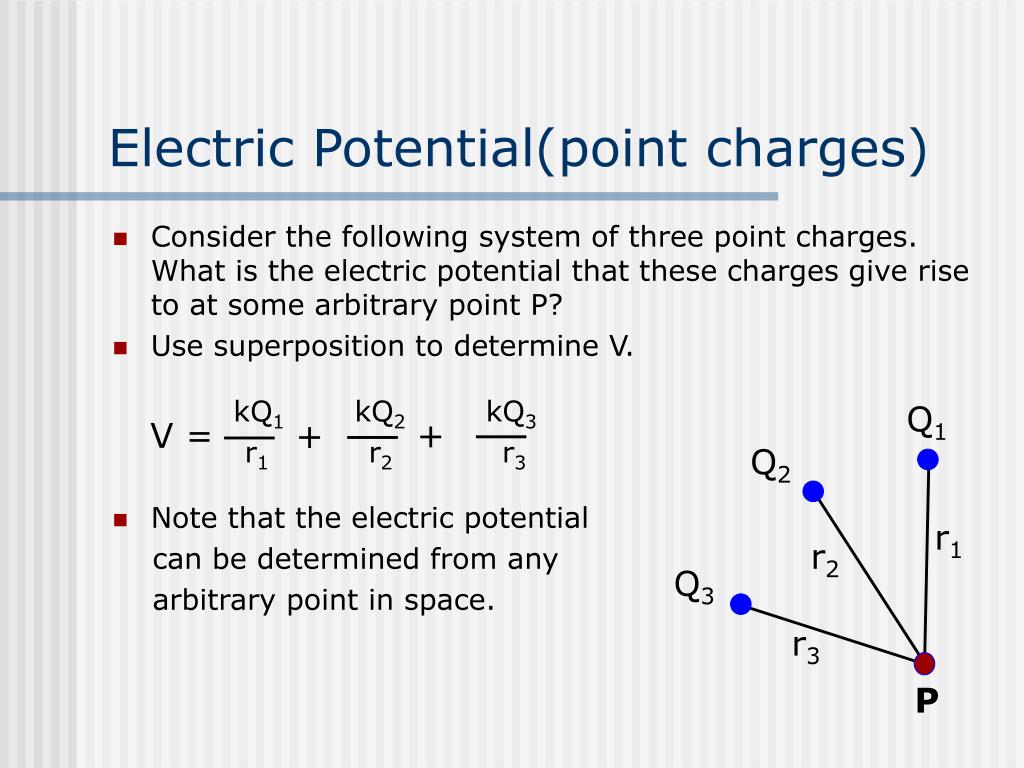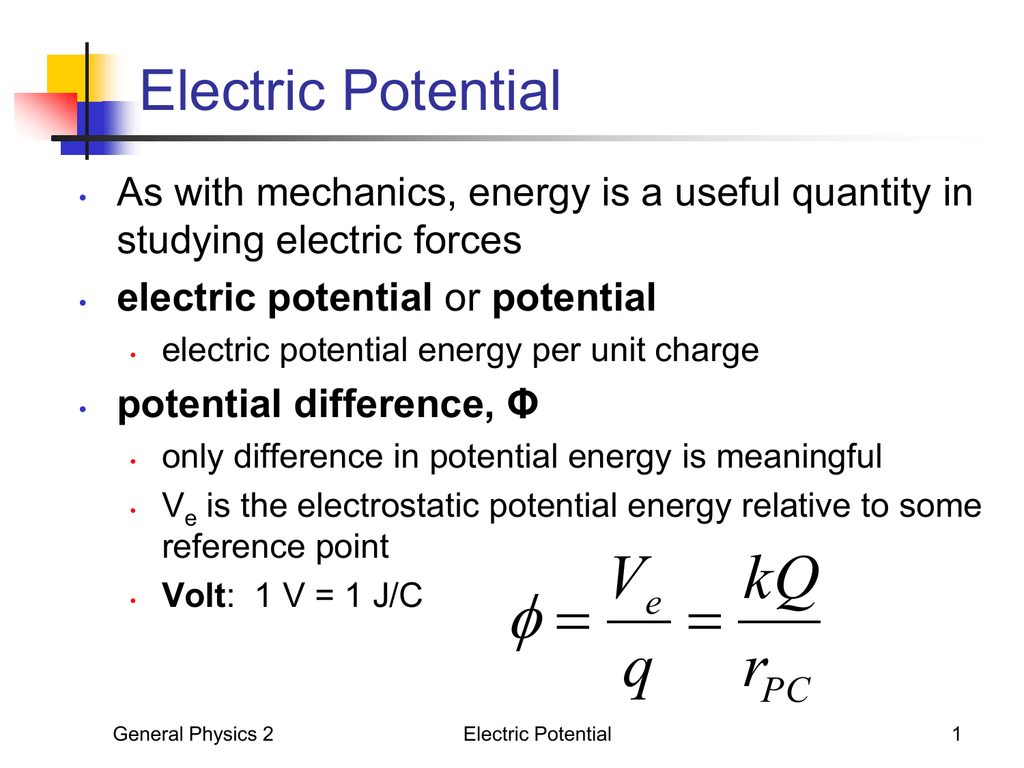Fabulous Tips About How Do You Calculate Electric Potential

Unlocking the Secrets of Electric Potential
Ever felt a zap when you touched a doorknob after shuffling across a carpet? Or maybe you've wondered how lightning works, without getting too close, of course? These phenomena are deeply connected to something called electric potential. It might sound intimidating, but trust me, understanding the basic principles of how to calculate electric potential can be surprisingly straightforward, and hey, even a little fun!
1. What Exactly Is Electric Potential, Anyway?
Think of electric potential as the "electrical height" at a particular point in an electric field. Imagine you're lifting a weight against gravity. The higher you lift it, the more potential energy it has. Similarly, the electric potential tells you how much potential energy a charged particle would have at that location due to the electric field. It's like a map of the electrical landscape, showing where the "hills" and "valleys" are for charged particles.
Unlike electric potential energy, which depends on the charge you're considering, electric potential is independent of the "test charge" you are looking at. Electric potential is a characteristic of the electric field itself. Put another way, it tells you how much work you'd have to do per unit charge to move a positive charge from a reference point (often infinity) to that specific location. A reference point is essentially where the electric potential is set to zero. Choosing the right reference point can really simplify calculations. It's usually at infinity, but in some situations, another convenient point is chosen.
It is very crucial to understand that electric potential is a scalar quantity, meaning it only has magnitude and no direction. This makes working with electric potential a lot easier than dealing with electric fields, which are vector quantities and require considering direction. You can think of it like temperature it tells you how "hot" or "cold" something is, but not which way the heat is flowing.
So, in a nutshell, electric potential is a measure of the electric potential energy per unit charge at a point in space. It's the electrical "height" that tells you how much work it would take to move a charge to that spot. Still with me? Great! Let's move on to the juicy part: how to actually calculate it.

How To Determine Electric Potential
The Formula That Rules Them All (Well, Some of Them...)
2. The Point Charge Scenario
Let's start with the simplest situation: calculating the electric potential due to a single point charge. The formula is surprisingly elegant:
V = kQ/r
Where:
- V is the electric potential (measured in volts)
- k is Coulomb's constant (approximately 8.99 x 109 N m2/C2)
- Q is the magnitude of the point charge (measured in coulombs)
- r is the distance from the point charge to the point where you want to know the potential (measured in meters)
See? Not so scary! This formula tells you that the electric potential decreases as you move further away from the charge. Makes sense, right? The closer you are to the charge, the stronger its influence, and therefore the higher the potential.
One super important thing to remember is that Q can be positive or negative. If Q is positive, the electric potential will be positive. If Q is negative, the electric potential will be negative. This means that positive charges create areas of high electric potential, while negative charges create areas of low electric potential.
Keep in mind that the formula V=kQ/r only applies for a point charge. So, if you have multiple point charges, you can simply calculate the electric potential due to each individual charge using this formula, and then add them up (because electric potential is a scalar quantity, we don't have to worry about directions!). This is called the superposition principle.

How To Calculate The Electric Potential
Stepping Up the Game
3. Superposition
Now, what if you have a bunch of charges hanging out together? No problem! Because electric potential is a scalar, you can use the principle of superposition. This means you simply calculate the electric potential due to each individual charge and then add them together. Easy peasy!
Let's say you have charges Q1, Q2, Q3, and so on, located at distances r1, r2, r3, etc., from the point where you want to find the potential. Then the total electric potential at that point is:
Vtotal = kQ1/r1 + kQ2/r2 + kQ3/r3 + ...
Just crunch the numbers for each charge and then add the results. Be careful with the signs of the charges! A negative charge contributes a negative potential.
Using this technique effectively is mostly about carefully organizing your data, labeling your charges and distances, and making sure not to lose a minus sign along the way. When problem solving, one way to improve your likelihood of arriving at the correct answer is to write down the known quantities, and only then consider the appropriate formulas to use.
4. When Charges Get Crowded
Things get a little more interesting when you have a continuous distribution of charge, like a charged rod or a charged disk. In these cases, you can't just add up individual charges. Instead, you need to use integration (uh oh, here it comes!).
The basic idea is to break the continuous charge distribution into infinitesimally small pieces of charge, dQ. Then, you treat each dQ as a point charge and calculate the electric potential it creates at the point of interest. Finally, you integrate over the entire charge distribution to find the total electric potential:
V = k dQ/r
This integral can sometimes be tricky to evaluate, depending on the geometry of the charge distribution. But don't worry, you're not alone! There are plenty of resources available online and in textbooks to help you with these types of integrals. This is where things can get a bit hairy, as the integral can be different depending on the geometry involved.
While the math might look scary, the core concept is still the same: add up the contributions from all the little bits of charge. The key is to express dQ in terms of a convenient coordinate system (like x, y, or ) and then integrate over the appropriate limits.

Electric Potential and Electric Field
5. The Gradient Relationship
Electric potential and electric field are closely related. In fact, the electric field is the negative gradient of the electric potential. What does that mean? Well, in simple terms, it means that the electric field points in the direction of the steepest decrease in electric potential.
Mathematically, this relationship is expressed as:
E = -VWhere E is the electric field (a vector) and V is the gradient of the electric potential (also a vector). In Cartesian coordinates, this becomes:
Ex = -V/x, Ey = -V/y, Ez = -V/z
This means that to find the x-component of the electric field, you take the partial derivative of the electric potential with respect to x (treating y and z as constants), and then multiply by -1. You do the same for the y and z components.
Think of it this way: imagine you're standing on a hill. The electric potential is like the height of the hill, and the electric field is like the direction and steepness of the slope. The electric field points downhill, in the direction where you'd roll the fastest.
6. Equipotential Surfaces
An equipotential surface is a surface on which the electric potential is constant. Imagine drawing a line (or a surface in 3D) connecting all the points that have the same electric potential. That's an equipotential line (or surface).
Equipotential surfaces are always perpendicular to electric field lines. This makes sense because if the electric field had a component parallel to the equipotential surface, it would mean that you could move a charge along that surface without doing any work (since the potential is constant). But this is impossible because the electric field does work on charges.
Understanding equipotential surfaces can be really helpful for visualizing electric fields. They're like contour lines on a topographic map, showing you the "elevation" of the electric potential. The closer the equipotential surfaces are to each other, the stronger the electric field is.
In practice, if you know the electric field, you can find the equipotential surfaces by solving the differential equation V = -E. Conversely, if you know the equipotential surfaces, you can find the electric field by taking the gradient. They are two sides of the same coin. Calculating and understanding equipotential surfaces helps provide greater insight into the nature of electric fields.

Electric Potential Formula
Practical Applications
7. Electronics
Electric potential plays a vital role in the design and analysis of electronic circuits. Voltage, which is the difference in electric potential between two points, is the driving force behind the flow of current in a circuit.
Batteries provide a voltage source, creating a potential difference that pushes electrons through the circuit. Resistors, capacitors, and other components manipulate the flow of current and the distribution of voltage, allowing us to build complex circuits that perform all sorts of amazing functions.
Understanding electric potential is essential for designing circuits that are safe, efficient, and reliable. By carefully controlling the voltage and current in a circuit, we can create devices that power our homes, run our computers, and connect us to the world.
It's important to consider things like potential dividers when designing circuits. A potential divider is a simple circuit that converts a large voltage into a smaller one. This type of voltage regulation is very important in sensitive electronic devices.
8. Medical Imaging
Electric potential also has important applications in medical imaging. For example, electrocardiography (ECG) measures the electric potential generated by the heart's electrical activity. By analyzing the ECG signal, doctors can diagnose heart conditions and monitor heart function.
Similarly, electroencephalography (EEG) measures the electric potential generated by the brain's electrical activity. EEG is used to diagnose epilepsy, sleep disorders, and other neurological conditions.
These techniques rely on the fact that the human body is a conductor of electricity, albeit not a perfect one. The electric potential generated by the heart and brain spreads throughout the body, and can be detected by electrodes placed on the skin.
Advances in medical imaging technology continue to leverage our understanding of electric potential. Techniques like Electrical Impedance Tomography (EIT) are being developed to create images of the body's internal structures based on their electrical properties. These technologies hold promise for improving the diagnosis and treatment of a wide range of medical conditions.

FAQs
9. Q
A: Electric potential is the electric potential energy per unit charge. Electric potential energy depends on the amount of charge you have, while electric potential is a property of the electric field itself.
10. Q
A: Electric potential is a scalar. It only has magnitude, not direction. This makes it much easier to work with than the electric field, which is a vector.
11. Q
A: The units of electric potential are volts (V). One volt is equal to one joule per coulomb (1 V = 1 J/C).
12. Q
A: A negative electric potential simply indicates that the potential at that point is lower than the reference potential (usually taken to be zero at infinity). Voltage is the difference in electric potential between two points. Therefore, a negative electric potential doesn't necessarily mean a negative voltage. Voltage is dependent on the reference point that we choose.